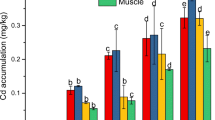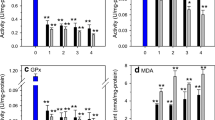Abstract
The objectives of this study were to determine the acute toxicity of cadmium and to examine the bioaccumulation and elimination of cadmium in different tissues of the freshwater prawn Macrobrachium sintangese. It also evaluated the structural damage of gills and hepatopancreas of M. sintangese when administered to sublethal cadmium concentration and when exposed prawns were transferred to cadmium-free media. According to the mortality data, the 96 h LC50 value of Cd to M. sintangese was 86 μg/L. The highest cadmium accumulation was observed in gills, followed by the hepatopancreas, and the abdominal muscle. After being transferred to cadmium-free media, the highest cadmium elimination was observed in abdominal muscle, followed by the gills and hepatopancreas. The gills of prawns exposed to cadmium exhibited a severe hyperplasia, vacuolization, and multiple necroses which resulted to the swelling of lamellae. After transferring the cadmium-exposed prawns into the control media, the histopathological effects decreased. Severe alterations to the hepatopancreatic tissue were observed in prawns exposed to cadmium. The tubular epithelial cells were heavily vacuolated and even ruptured. The number of large vacuoles and R cells appeared in the tubular epithelial cells of the hepatopancreas. After transferring to the control media, the histological alterations of the hepatopancreas decreased. The tubular epithelial cells began to rearrange to the normal structure. The number of R cells and B cells were noted in the epithelial cells. The thickness of tubular epithelial cells was comparable to the controls. Due to the sensitivity of M. sintangese to cadmium, therefore this species potentially can be used as a test organism in toxicity assays.



Similar content being viewed by others
References
Alikhan, M. A. (1989). Magnesium and manganese regulation during moult-cycle in Porcellio spinicornis Say (Porcellionidae, Isopoda). Bulletin of Environmental Contamination and Toxicology, 42, 699–706.
Amiard-Triquet, C., Berthet, B., Metayer, C., & Amiard, J. C. (1986). Contribution to ecotoxicological study of cadmium, copper and zinc in the mussel Mytilus edulis. Marine Biology, 92, 7–13.
Ardiansyah, S., Irawan, B., & Soegianto, A. (2012). Effect of cadmium and zinc in different salinity levels on survival and osmoregulation of white shrimp (Litopenaeus vannamei Boone). Marine and Freshwater Behaviour and Physiology, 45, 291–302.
Ayotunde, E. O., Offem, B. O., Okey, I. B., Ikpi, G. U., Ochang, S. N., Agbam, N. E., & Omini, D. E. (2011). Toxicity of pawpaw (Carica papaya) seed powder to sharptooth catfish Clarias gariepinus fingerlings and effects on haematological parameters. International Journal Fish Aquaculture, 2, 71–78.
Bambang, Y., Charmantier, G., Thuet, P., & Trilles, J. P. (1995). Effects of cadmium on survival and osmoregulation of various developmental stages of the shrimp Penaeus japonicus Bate (Crustacea: Decapoda). Marine Biology, 123, 443–450.
Bautista, M. N., Lavilla-Pitogo, C. R., & Subosa, P. F. (1994). Aflatoxin B1 contamination of shrimp feeds and its effect on growth and hepatopancreas of pre-adult Penaeus monodon. Journal of the Science of Food and Agriculture, 65, 5–11.
Bentley, P. J. (1992). Influx of zinc by channel catfish (Ictalurus punctatus): uptake from external environmental solutions. Comparative Biochemistry and Physiology, C101, 215–217.
Bjerregaard, P. (1990). Influence of physiological condition on cadmium transport from haemolymph to hepatopancreas in Carcinus maenas. Marine Biology, 106, 199–209.
Brown, B. E. (1982). The form and function of metal containing granules in invertebrate tissues. Biological Reviews, 57, 621–667.
Caceci, T., Neck, K. F., Lewis, D. H., & Sis, R. F. (1988). Ultrastructure of the hepatopancreas of the Pacific white shrimp, Penaeus vannamei (Crustacea: Decapoda). Journal of the Marine Biological Association of the UK, 68, 323–337.
Dall, W., & Moriarty, D. J. W. (1983). Functional aspects of nutrition and digestion. In L. H. Mantel (Ed.), The biology of crustacean, internal anatomy and physiological regulation (Vol. 5, pp. 215–261). New York: Academic.
Douben, P. E. T. (1989). Metabolic rate and uptake and loss of cadmium from food by the fish Neomacheilus barbatus (Stone Loach). Environmental Pollution, 59, 177–202.
Fafioye, O. O., & Ogunsanwo, B. M. (2007). The comparative toxicities of cadmium, copper and lead to Macrobrachium rosenbergii and Penaeus monodon postlarvae. African Journal of Agricultural Research, 2, 31–35.
Frias-Espericueta, M. G., Castro-Longoria, R., Barron-Gallardo, G. J., Osuna-Lopez, J. I., Abad-Rosales, S. M., Paez-Osuna, F., & Voltolina, D. (2008). Histological changes and survival of Litopenaeus vannamei juveniles with different copper concentrations. Aquaculture, 278, 97–100.
Greco, L. S. L., Sanchez, M. V., Nicoloso, G. L., Medesani, D. A., & Rodriguez, E. M. (2001). Toxicity of cadmium and copper on larval and juvenile stages of the estuarine crab Chasmagnathus granulate (Brachyura, Grapsidae). Archives of Environmental Contamination and Toxicology, 41, 333–338.
Heath, A. G. (1987). Water pollution and fish physiology. Florida: CRC press.
Johnson, D. S. (1963). Distributional and other notes on some freshwater prawn (Atyidae and Palaemonidae) mainly from the Indo-West Pacific Region. Bulletin National Museum of Singapore, 32, 5–30.
Karin, M. (1985). Metallothioneins: proteins in search of function. Cell, 41, 9–10.
Langston, W. J. (1990). Toxic effects of metals and the incidence of marine ecosystems. In R. W. Furness & P. S. Rainbow (Eds.), Heavy metals in the marine environment (p. 256). New York: CRC press.
Li, N., Zhao, Y., & Yang, J. (2007). Impact of waterborne copper on the structure of gills and hepatopancreas and its impact on the content of metallothionein in juvenile giant freshwater prawn Macrobrachium rosenbergii (Crustacea: Decapoda). Archives of Environmental Contamination and Toxicology, 52, 73–79.
Lignot, J. H., Pannier, F., Trilles, J. P., & Charmantier, G. (1998). Effects of tributyltin oxide on survival and osmoregulation of the shrimp Penaeus japonicus (Crustacean, Decapoda). Aquatic Toxicology, 41, 277–299.
Lignot, J. H., Trilles, J. P., & Charmantier, G. (1997). Effects of an organophosphorus insecticide, fenitrothion, on survival and osmoregulation of various developmental stages of the shrimp Penaeus japonicus (Crustacea: Decapoda). Marine Biology, 128, 307–316.
Lock, R. A. C., & Overbeeke, A. P. V. (1981). Effects of mercuric chloride and methylmercuric chloride on mucus secretion in rainbow trout Salmo gairdneri Richardon. Comparative Biochemistry and Physiology, 69C, 67–73.
Mallat, J. (1985). Fish gill structural changes induced by toxicants and their irritants: a statistical review. Canadian Journal of Fisheries and Aquatic Sciences, 42, 630–648.
Martin, D. J., & Rainbow, P. S. (1998). The kinetics of zinc and cadmium in the haemolymph of the shore crab Carcinus maenas. Aquatic Toxicology, 40, 203–231.
Martins, C. D. M. G., Barcarolli, I. F., de Menezes, E. J., Giacomin, M. M., Wood, C. M., & Bianchini, A. (2011). Acute toxicity, accumulation and tissue distribution of copper in the blue crab Callinectes sapidus acclimated to different salinities: In vivo and in vitro studies. Aquatic Toxicology, 101, 88–99.
Mohamad, A. S. A. (1982). Some observations on the biology of Macrobrachium sintangense (De Man) in Juanda Reservoir (Jatiluhur), West Java, with notes on its fishery and general distribution. Biotropia Bulletin, 20, 1–31.
Mormede, S., & Davies, I. M. (2001). Heavy metal concentrations in commercial deep-sea fish from the Rockall Trough. Continental Shelf Research, 21, 899–916.
Muramoto, S. (1983). Elimination of copper from Cu-contaminated fish by long-term exposure to EDTA and freshwater. Journal of Environmental Science and Health, A18, 455–461.
Offem, B. O., & Ayotunde, E. O. (2008). Toxicity of lead to freshwater invertebrates (water fleas; Daphnia magna and Cyclop sp.) in fish ponds in a tropical floodplain. Water, Air, and Soil Pollution, 192, 39–46.
Pages, A. L., El-Amamy, M. M., & Chang, A. C. (1986). Cadmium in the environment and its entry into terrestrial food chain crops. In E. C. Foulkes (Ed.), Cadmium (pp. 33–97). Berlin: Springer.
Palaniappan, P. L. R. M., & Karthikeyan, S. (2009). Biaccumulation and depuration of chromium in the selected organs and whole body tissues of the freshwater fish Cirrhinus mrigala individually and in binary solutions with nickel. Journal of Environmental Sciences, 21, 229–236.
Rainbow, P. S. (2002). Trace metal concentrations in aquatic invertebrates: why and so what? Environmental Pollution, 120, 497–507.
Rainbow, P. S., & White, S. L. (1990). Comparative accumulation of cobalt by three crustacean: a decapods, an amphipod and barnacle. Aquatic Toxicology, 16, 113–126.
Schiaffino, S., & Reggiani, C. (1996). Molecular diversity of myofibrillar proteins: gene regulation and functional significance. Physical Review, 76, 371–423.
Soegianto, A., Charmantier-Daures, M., Trilles, J. P., & Charmantier, G. (1999a). Impact of cadmium on the structure of gills and epipodites of the shrimp Penaeus japonicus. Aquatic Living Resources, 12, 57–70.
Soegianto, A., Charmantier-Daures, M., Trilles, J. P., & Charmantier, G. (1999b). Impact of copper on the structure of gills and epipodites of the shrimp Penaeus japonicus. Journal of Crustacean Biology, 19, 209–223.
Sprague, J. B. (1969). Measurement of pollutant toxicity to fish. I. Bioassay methods for acute toxicity. Water Research, 3, 793–821.
Viarengo, A., Palmero, S., Zanicchi, G., Capelli, R., Vaissiere, R., & Orunesu, M. (1985). Role of metallothioneins in Cu and Cd accumulation and elimination in the gill and digestive gland cells of Mytilus galloprovincialis Lam. Marine Environmental Research, 16, 23–36.
Victor, B., Narayanan, M., & Nelson, D. J. (1990). Gill pathology and hemocyte response in mercury exposed Macrobrachium idea (Heller). Journal of Environmental Biology, 11, 61–65.
Vogt, G. (1990). Pathology of midgut gland cells of Penaeus monodon post larvae after Leucaena leucocephala feeding. Diseases of Aquatic Organisms, 9, 45–61.
White, S. L., & Rainbow, P. S. (1986). Accumulation of cadmium by Palaemon elegans (Crustacea: Decapoda). Marine Ecology Progress Series, 32, 17–25.
Woo, P. T. K., Yoke, M. S., & Wong, M. K. (1993). The effects of short-term acute cadmium exposure on blue tilapia, Oreochromis aureus. Environmental Biology of Fisheries, 37, 67–74.
Wu, J. P., Chen, H. C., & Huang, D. J. (2008). Histopathological and biochemical evidence of hepatopancreatic toxicity caused by cadmium and zinc in the white shrimp, Litopenaeus vannamei. Chemosphere, 73, 1019–1026.
Wu, J. P., Chen, H. C., & Huang, D. J. (2009). Histopathological alterations in gills of white shrimp, Litopenaeus vannamei (Boone) after acute exposure to cadmium and zinc. Bulletin of Environmental Contamination and Toxicology, 82, 90–95.
Wu, J. P., & Chen, H. C. (2004). Effects of cadmium and zinc on oxygen consumption, ammonium excretion, and osmoregulation of white shrimp (Litopenaeus vannamei). Chemosphere, 57, 1591–1598.
Acknowledgments
This research was partly supported by grants from the Ministry of Research and Technology of Indonesia. We are grateful to Miss A.N. Primarastri for histological work, Mrs. Setiyanto and Giman for the technical assistances during the experiments. We also wish to thank anonymous reviewers for valuable advice and constructive comments to improve the manuscript.
Author information
Authors and Affiliations
Corresponding author
Rights and permissions
About this article
Cite this article
Soegianto, A., Winarni, D., Handayani, U.S. et al. Bioaccumulation, Elimination, and Toxic Effect of Cadmium on Structure of Gills and Hepatopancreas of Freshwater Prawn Macrobrachium sintangese (De Man, 1898). Water Air Soil Pollut 224, 1575 (2013). https://doi.org/10.1007/s11270-013-1575-4
Received:
Accepted:
Published:
DOI: https://doi.org/10.1007/s11270-013-1575-4




